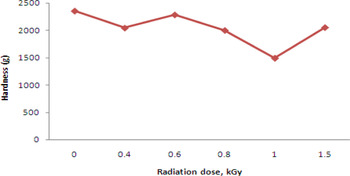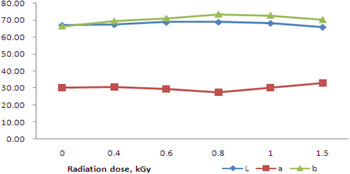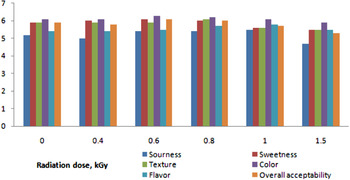This study investigated the effect of gamma irradiation of ‘Navel’ oranges. The samples were irradiated at doses of 0, 0.4, 0.6, 0.8, 1 and 1.5 kGy and the radiation absorbed dose was 600 Gy/h. To identify the effects of quality characteristics in gamma-irradiated Navel orange, microbiological, physicochemical and sensory qualities were investigated.

Fig. 1. Microbiological values.

Fig. 2. Hardness(g).

Fig. 3. Hunter color values of peel.

Fig. 4. Sensory scores.
Figure 1 shows that the total aerobic bacterial, yeast and mold counts in non-irradiated oranges were 3.59 and 3.75 log CFU/g, and irradiated oranges of 1.5 kGy were decreased 1.75 and 2.26 log CFU/g, respectively. Those counts were decreased significantly (p<0.05) according to dose-dependent manner after gamma irradiation. The hardness was decreased irradiated sample compared to control sample, but the value revealed no significant difference (Fig. 2). The Hunter color values revealed no significant difference after gamma irradiation (Fig. 3). Figure 4 shows that sensory evaluation testing revealed no significant difference between control sample and irradiated samples, except in 1.5 kGy. Samples irradiated at 1.5 kGy were the lowest one throughout color, sweetness, sourness, flavor, texture and overall acceptability. The results suggest that gamma irradiation was effective to ensure the microbiological safety, but irradiated oranges of 1.5 kGy showed the lowest score on physicochemical and sensory qualities.
This research was supported by Export Promotion Technology Development Program, Ministry for Food, Agriculture, Forestry and Fisheries, Republic of Korea.








